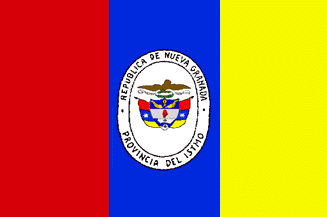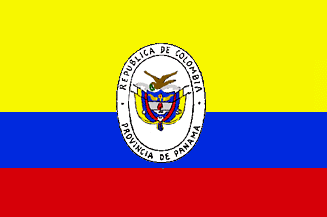Panama - Historical Flags (original) (raw)

This page is part of © FOTW Flags Of The World website
Last modified: 2020-04-18 by rob raeside
Keywords: panama | istmo | isthmus |
Links: FOTW homepage |search | disclaimer and copyright | write us | mirrors
- 1821 Flag
- 1834 Flag
- 1855 Flag
- 1861 Flags
- 1886 Flag
- 1903 First flag (Proposal)
- Flag of 3 November - 20 December 1903
- Flag of 9 January 1964
See also
1821 Flag
Panama as Province of Istmo (Isthmus) in the Republic of Colombia
Adopted: 6 Octuber 1821.
1834 Flag
Panama as Province of Istmo (Isthmus) in the Republic of New Granada
Adopted: 9 May 1834. Abolished: 1855.
1855 Flag
Panama as a State in the Granadine Confederation
Adopted: 1855. Abolished: 26 July 1861.
1861 Flags
Panama as a State in the United States of New Granada
Panama as a State in the United States of Colombia
Adopted: 26 November 1861. Abolished: 1886.
1886 Flag
Panama as a Province in the Republic of Colombia
Adopted: 1886. Abolished: 3 November 1903.
1903 First Flag (Proposal)
[![[First Flag of Panama]](http://www.crwflags.com/fotw/images/p/pa-first.gif) ](../images/p/pa-first.gif) image by Jaume Ollé , 4 September 1996
](../images/p/pa-first.gif) image by Jaume Ollé , 4 September 1996
The flag was proposed by Felipe Bunau Varilla before independence.
Jaume Ollé, 4 September 1996
This is not the "First Flag" but a proposal by Philippe Bunau Varilla that was rejected by the Panama government because it was too much like the U.S. flag and never became official.
Alvaro Aguilar , 21 December 1999
From [udk97] : "The first flag, proposed in 1903, consisted of SEVEN horizontal stripes of red and yellow, with a blue canton containing two golden suns, joined by a narrow line to depict the oceans to be united by the Panama Canal" . The image above has THIRTEEN horizontal stripes !?
Ivan Sache, 26 December 1999
The first flag proposed was a version of the flag of the United States of America, designed and proposed by the insidious Frenchman Phillipe Buneau/Varilla, where the stripes were yellow and red and on the blue rectangle, instead of fifty stars, had o an enormous yellow sun. It was immediately, and mercifully rejected unanimously.
Charles F. Brannan-Jaen, 20 July 2009
Flag of 3 November - 20 December 1903
[![[1903 Flag of Panama]](http://www.crwflags.com/fotw/images/p/pa-1903.gif) ](../images/p/pa-1903.gif) image by Željko Heimer, 6 January 1996
](../images/p/pa-1903.gif) image by Željko Heimer, 6 January 1996
3 November - 20 December 1903
This flag was drawn by Manuel Amador, son of the first President of the Republic, and made by his mother Maria Ossa de Amador. Basically it is the same as the current national flag but the colours are in a different order. The flag was used from 3 November 1903 to 20 December 1903. After this date the order was changed for unknown reasons, and the new flag (the current flag) was adopted oficially by law 64 of 4 June 1904. In 1906 a competition for a new national flag was initiated, but the flag not was changed.
Jaume Ollé , 4September 1996
Panama had three official flags during the year 1903. The first is the flag of the Province of Panama within the Colombian Republic - the last pre-independence flag. The second flag (above) is similar to the present flag, but not the same. This almost similar flag places the all-blue quarter in the top hoist, and the blue star in the lower hoist (and also flips the red elements in an analogous fashion). According to our research, this flag was the flag of Panama for a very short period of time: 3 November 1903 to 20 December 1903. After 20 December, Panama had its third flag of the year - the present day flag. This flag was first used at the end of 1903, but not officially adopted until 1904.
Steve Kramer, 27 April 2003
I must inform you that Manuel Encarnacion Guerrero (not Manuel Amador Guerrero) designed the flag. Manuel Encarnacion was Dr. Amador Guerrero’s son from a previous marriage and a stepson to Doña Maria Ossa de Amador, who although generally credited with sewing the first flag, assisted by her sister in law.
However, Mme Gerrero did not know how to operate a sewing machine, but her seamstress sister in law did, and had the requisite machine. Therefore, some historians insist Mme.Guerrero took credit unjustly.
To be objective and fair, about which lady did the actual handiwork, I have to say, having examined the original flag on display at our Museum, that it’s a desperately (although it’s a kind of desperate beauty) amateurish effort at sewing. Maybe the pressure, stress, the uncertainty of discovery in participating in a treacherous conspiracy punishable by firing squad, but no expert seamstress sewed that flag.
Charles F. Brannan-Jaen, 20 July 2009
Flag of 9 January 1964
Rolando de la Guardia Wald reports in "La Prensa", 9 January 2007:
" In a corner of the library of the National Institute, protected by a fragile crystal box, is shown the flag raised by the students of the National Institute in the Canal Zone on 9 January 1964. According to Rimsky Sucre, former President on the Association of the National Institute "Generation 64", the flag was originally kept in a card box at the National Institute of Culture. The flag was later relocated where it is shown today, in inappropriate conditions, without control of humidity, so that fungi have already significantly spoiled the flag. The 9 January 1964 can be considered as "illegal" because it has a fringe and the national shield as well as the name of the National Institute embroidered in the middle. It was torn during the confrontation between the students who wanted to hoist the flag and the so-called "Zonians", the American students who then studied at Balboa High School.
This flag represents a strong symbol for the "institutores" and the Panamanians, therefore the need to restore it and to show it as a symbol of the Panamanian national identity. In 2004-2005, Sucre, who was involved in the 9 January movement, exchanged letters with the art restorer Antón Rajer in order to restore "this symbol of the Panamanian sovereignty". Rajar accepted to be watched during his works by students from the National Institute. He sprayed special products in order to get rid of the fungi, dried up the flag and sewed it, piece by piece, on a canvass made of a specific fabric. The flag immediately placed under vacuum in an urn with a frame made of bronze.
There are two versions of the origin of this flag. Several students claim that the flag was used in demonstration before the 9 January event. Guillermo Guevara Paz, then a fourth-year student, wrote in " La Estrella de Panamá" on 1' January 1964 that Francisco Díaz had been allowed to raise the flag of the National Institute by Rector Dídimo Ríos: "We used - as it was said - the flag that had already been used in the 12 December 1948 movement [against the Filos-Hines treaty], in May 1958 (Operation Sovereignty) and also on 3 November 1959. It was said that the flag was stained with the blood of "the martyrs of the Federation of the Students of Panamá".
Carlos Arrieta de la Hoz, former Professor and Rector of the National Institute, recalls that the 9 January flag was the first ever used by the National Institute; it was a grant by the Director of the National Lottery, Guillermo Quijano (1960-1964) and could therefore not have been used in former demonstrations."
Historical background on the 9 January 1964 events and their consequences can be read on: www.czbrats.comand www.czbrats.com/Flag_pole.htm.
Ivan Sache, 6 February 2007





